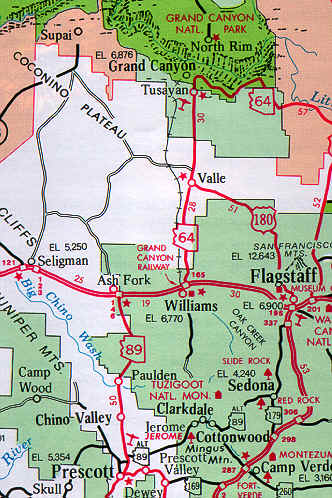Regional
Map
of
Northern
Arzonia

RegionalMapofNorthernArzonia |
 |
WilliamsWilliams (circa 1940) served travelers as part of the "Main Street of America." Route 66, now Bill Williams Avenue, is still lined with businesses dating from the highway's heyday. In 1984 Williams became the last route 66 town in America to be by passed by interstate 40. One of few sections on the old road are now listed on the national Register of Historic Places. Easy to follow auto tour brochures may be obtained at the Chamber offices. Located in the Kaibab National forest, at an elevation of 6,780. Williams experiences a four season climate. Founded in 1880 and named for the famous trapper, scout and mountain man. Bill Williams.. Williams is the Gateway to the Grand Canyon. The Grand Canyon, one of the seven natural wonders of the world, is only a short distance north of Williams. Grand Canyon Railway operates year round and is based in Williams. Restored 1901 Steam trains provide a comfortable scenic ride to the South Rim of Grand Canyon and return the same day. Many lakes and campgrounds surround Williams. Fishing is good for trout, crappie, catfish and small mouth bass. Williams hosts several rodeos throughout the year attracting participants and spectators from all over the United States. Surrounded by a Ponderosa Pine forest, Top of the page SedonaSedona is nature's own magnificent masterwork with towering spires of red rock under turquoise skies. Scared to the Anasazi, its mystery draws millions of visitors every year. For over half a century Sedona has been a home and inspiration to such diverse geniuses as max Ernst, Orson Welles, and one of the founders of the Cowboy artists of America, Joe Beeler. Rivaling Scottsdale and Santa Fe, it is a famed mecca for art lovers and collectors from around the world. Sedona and Jerome Through the Historic Verde Valley to the famous red rocks of Sedona on Hwy. 89A, dedicated as one of America's most scenic highways. Top of the Page JeromeOn the side of mingus mountain, you'll see Jerome, the old mining center that has emerged from its ghost town days to become an enclave of galleries and restaurants. You will go through Clarkdale and Cottonwood and learn about the Singagua Indians at Tuzigoot national Monument Sedona is red rock scenery you won't believe and more galleries thatn you can count. Top of the page FlagstaffOver the old Soldier's Trail, through Prescott Valley where centuries old Indian caves and pottery have been found, then through Dewey and over to Camp Verde, where a cavalry outpost was established in 1865 to protect settlers along the Verde River. Heading north, you'll find Montezuma Castle, Indian cliff dwellings built by Sinaguas in the 12th and 13th centuries, then on to Montezuma Well, a natural limestone sinkhole surrounded by more Indian cliff dwellings. Last stop, Flagstaff has an outstanding observatory, museums, antiques and galleries. Flagstaff's Snowbowl has 33 ski trails in the San Francisco Peaks, with year-round lift rides. Top of the pageThe Grand CanyonThe Grand Canyon, one of the Seven Wonders of the World. The awesome beauty of the Canyon will put everything you've ever thought about into a clearer perspective. From Prescott, you will head north through the historic towns of Chino Valley, Paulden, Ash Fork, and the old lumber and railroad town of Williams. This easy-driving round-trip of about 265 miles takes you through the plains and forests of the Arizona's Old West. Top of the page PrescottLocated in the nation's largest contiguous forest of Ponderosa pines, Prescott is a beautiful mile-high city rich in the lore of the American West and complete in the amenities desired by modern travelers. Abundant in its own assets, from the historic Courthouse Plaza to fine golf courses,, Prescott is a favorite gateway to the sounders of Arizona's Northland. With everything from excellent hotels to Victorian bed & breadfast inns, Prescott is the ideal visitors' "base camp," Offering comfortable day-trips to the magestic Grand Canyon, fantastic local shopping and the hard-to-believe red rocks of Sedona. After a good dinner and a comfortable downtown walk, you'll see why Prescott is internationally-known as "Everybody's Hometown." Like so many others, you may come back to Prescott from time to time just to feel good.The town of prescott was founded not too long after gold was discovered in nearby hills in 1863, the same year Abraham Lincoln signed an act to create the Arizona Territory. Prescott became Arizona's first territorial capital and the region's economic center. Much of what was diveloped in those early days is preserved here today--famous Whiskey row, the downtown Courthouse Plaza and the first territorial governor's residence. Prescott has approximately 525 buildings on the national Register of Historic Places. Prescott's gentle four seasons make it a splendid place to relax and have fun any time of the year. In winter, Prescott's afternoons are usually in the 50s while much of the nation is frigid. During summer, average highs are in the 80s when Arizona's desers are over 100. And the pristine freshness of the spring and invigorating crispness of fall are hard to beat anywhere. When it comes to life in the great out-doors, the Prescott area has it all! Four 18 hole gold courses, horse racing, mountain hiking, rock climbing on the renowned Dells, Thumb Butte and Granite Mountain During Fourth of July week, Prescott becomes Main Street U.S.A. offering a traditional downtown parade and patriotic programs and topping it all off with "The World's Oldest Rodeo." Every December, the lighted and decorated Courthouse Plaza lets Prescott live up to its title of "Arizona's Christmas City." . Top of the page |